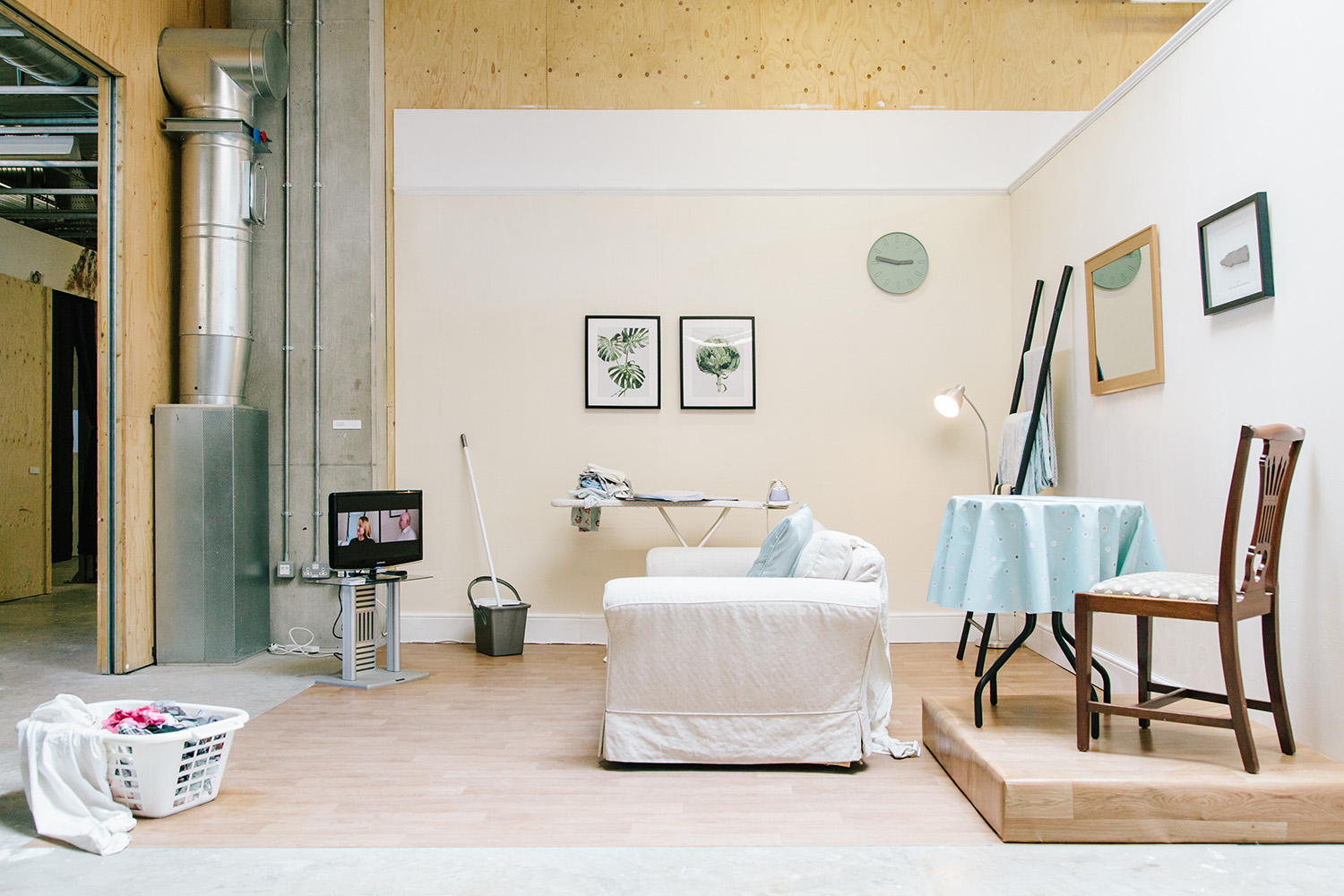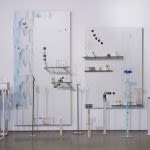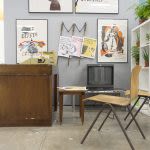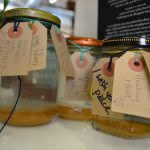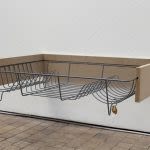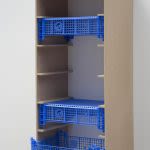As Degree Show One: Art draws to a close today, we take a look the themes which have emerged from the diverse range of works on view this year.
There are plenty of places to make yourself at home in Show One: living rooms, sofas, cushions, rugs, kitchens, offices and even a toilet. Meticulously crafted, these domestic settings have been wholly transported into the College, evoking the familiarity of our own, home environments. Utilitarian objects and materials also reoccur throughout the exhibition, with students across Fine Art, Art and Science and Photography incorporating items such as towels, fruit, bed sheets, plants, saucepans and ironing boards. Drawing on themes of domesticity in various ways, our students have been transforming our spaces into their very own.

Thora Chwae, Kitchen, 2018, Central Saint Martins Degree Show One: Art, Installation View, 2018
BA Fine Art student Thora Chwae has installed a fully-functioning kitchenette outside the canteen, complete with sink, oven, hob and kitchen table and chairs. Chwae’s transplanted room is influenced by the Slow Food movement and Neo-gastronomy. The Slow Food movement encourages a concept of food defined by the principles of goodness, cleanliness and fairness. In extension, Neo-gastronomy is a multidisciplinary approach which forges the connections between plate, planet, people and culture. Chwae’s references to the movement signify food as a vehicle for narratives – to tell stories and revalue them, presenting, as she terms it, “one’s life on a plate”. For Chwae, food is a translation of “human history and our ways of living”, it condenses our values, creativity and knowledge. By recreating the domestic environment of the kitchen, a place for cooking, eating and sharing, she attempts to elicit a new understanding of ourselves through the frame of food.

Yangbo Liu, My Comfortable Space, 2018, Central Saint Martins Degree Show One: Art, Installation View, 2018

Yangbo Liu, Orange Toilet, 2018. Photo: Vic Phillips
Nearby in The Street, 3D BA Fine Art student Yangbo Liu has constructed a toilet cubicle. The door to Liu’s toilet is made up of a one-way mirror, allowing the visitor inside to see those outside. Behind the cubicle, another empty toilet bowl offers a pile of oranges for the taking. Liu’s structure is a monument to the importance of personal privacy, illustrating his own definition of “comfort”. As he explains, “In traditional Chinese families, no one actually has that much personal space. We value the sense of responsibility and collectivism, so it is difficult for us to have a distinct, individual self in daily life.” For him, the bathroom became a sanctuary of private space – it is, traditionally, the space we inhabit without the company of others. Initially full of Liu’s personal belongings including books, plants and framed pictures, he decided to remove all items, leaving an empty, clinical space which references the solitary refuge of this domestic space. Interested in the relationships between spatial structures and human beings, Liu’s work is an exploration into the possibility of personal, private space in a public area.

Jessica Donnelly, Michael and Me, 2018, Central Saint Martins Degree Show One: Art, Installation View, 2018. Photo: Vic Phillips
For her work Michael and Me, Jessica Donnelly has recreated a living room, with a muted colour palette of cream and blue. A laundry basket sits atop the freshly-laid vinyl floor, bed sheets spilling out. A mop and bucket is propped up against the wall, next to an ironing board seemingly abandoned mid-task, iron still plugged in. A colour-coordinated sofa sits in the middle of the “room”, facing a live TV unit. Collectively, Donnelly’s objects signify a “living room”, the mundanity of her chosen furniture evoking a “standardised” space. As Donnelly puts it, “[these rooms] are a myth we create in our minds as domestic beings, in order to feel we are keeping up within a conventional lifestyle, when in reality, we couldn’t be further from it.’ Does our need to fill the corners of rooms, to decorate our empty walls, to present our characters through our things, allow us to address our own selves, or is it a chance to hide our selves behind objects?

Lenny Watson, Trouble in Clubland, 2018, Central Saint Martins Degree Show One: Art, Installation View, 2018
4D BA Fine Art student Lenny Watson’s installation Trouble in Clubland also relies on the domestic symbolism of the sofa, although here it is surrounded by the chaos of empty beer cans and cigarette ends. Watson’s sofa is upholstered in a battered, scratched leather; the walls are stark and white, the floor is bare and uncovered; the large TV is the focal point of the room setup, with a substantial sound-system. In the last decade, nearly 40% of live music venues have closed, meaning nightlife culture is increasingly relocated to small-scale and domestic environments. Using motifs and objects which are reminiscent of contemporary nightlife, Watson’s Degree Show work addresses the implications of a decline in live music venues on music culture more broadly.

Carmen Ng, Caged, 2018, Central Saint Martins Degree Show One: Art, Installation View, 2018

Carmen Ng, Caged, 2018, Central Saint Martins Degree Show One: Art, Installation View, 2018
While the majority of these built environments evoke the “home” for its connotations of enjoyment, comfort or safety, 3D BA Fine Art student Carmen Ng’s construction highlights the precarious state of private housing in Hong Kong. For the past eight years, Hong Kong has been given the statistic of least affordable housing market in the world. Luxury houses are built in huge numbers, in place of necessary public subsidised housing. Ng’s enclosed structure at Degree Show is a recreation of the ‘cage houses’ – subdivided flats resembling small cubicles, which Ng describes as “even smaller than a coffin”— that around 100,000 Hong Kong residents live in. Ng is interested in drawing attention to the paradoxical state of Hong Kong, and the seemingly invisible crisis of its housing market. Her box-like edifice is a startling, albeit temporary, experience of the domestic confines of these hidden communities.

Alix Emery, A Perfect Vacuum (Empty Cell), 2018, Central Saint Martins Degree Show One: Art, Installation View, 2018
It is not solely through the reconstruction of familiar rooms that students have incorporated domestic elements into their work. 2D BA Fine Art student Alix Emery’s Degree Show installations include objects such as hoovers, hose piping, duct tape, a loaf of bread and a saucepan. A Perfect Vacuum (Empty Cell) consists of two character hoovers, connected by a flexible hose tube, sitting over a rectangle of the floor which has been thoroughly and precisely cleaned. Set against the rest of the painterly studio floor, this clean area stands out in stark contrast. Emery’s material outcome replaces the romantic notion of an artist’s, paint-splattered studio with the practical action of cleaning and removal. The dimensions of the negative space she has created are dictated by the standard size of a prison cell. Through her nonsensical structures comprised of bleak and day to day objects, Emery addresses notions of the abject: what we clean, brush or wipe away and the structures we employ to do so.

Sophie Castle, Bribed With Gin and Tonic, 2018
As a painter, Sophie Castle explores intimacy in relationships, often depicting mundane, everyday actions. Repeatedly painting herself and her boyfriend naked, she uses the historical motif of the nude to counter and empower a body-obsessed generation. Alongside Castle’s large-scale figurative paintings, one canvas is filled with her handwritten notes, denouncing female stereotypes and the role of the “subordinate” muse. Large portions and single words are scratched out, as though it has been edited, refusing a straight forward reading of the narrative. Gradually, the writing becomes smaller, until it is unreadable at the bottom of the canvas, veering diagonally and vertically. Castle’s canvas here is in fact a used bed sheet, constructed so it drapes over the front corners, obscuring a question that Castle has begun, ‘Can you read’.

Rebecca Leach McDonald, Mythically Imagining King’s Cross, 2018 Central Saint Martins Degree Show One: Art, Installation View, 2018
The appropriation of the “domestic” continues throughout Show One, with 3D BA Fine Art student Tom Bull using supermarket mushroom trays, tea towels and a drying rack in his small-scale sculptural assemblages, and MA Art and Science students Liv Bargman and Rebecca Leach McDonald creating room installations. Bargman’s Office for Good Measure is a fictional, governmental office with wooden furniture and promotional material, while next door, McDonald’s is an inside-out domestic space, full of floor cushions, rugs and tie-dye tapestries, which charts the changing relationship between humans and the environments they live in, themed around the mythology of the Valley of the River Fleet. MA Fine Art student Sofia Bonato incorporates daily cosmetics such as toothpaste and hair-dye into her multi-faceted practice, drawing parallels between our levels of consumption and environmental damage. Across Show One, the use of the domestic ranges from everyday, mundane materials to the recreation of full immersive habitats. Whether recreating pre-existing rooms, or creating fabricated ones, these works dissolve the boundary between an exhibition setting and a personal one. Taking materials directly from familiar surroundings, these students are presenting both a personal and universal environment for us to inhabit.
Gallery
Degree Show One: Art ran from 23–27 May 2018. Degree Show Two: Design will open on 20 June and will be open to the public until 24 June 2018.
More:
- Visit the Degree Show One: Art website
- Read about MA Fine Art
- Read about BA Fine Art
- Read about MA Art and Science
- Read about MA Photography
